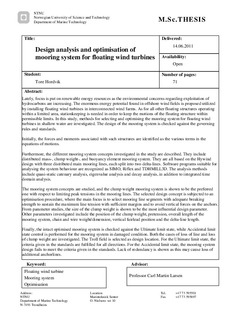| dc.description.abstract | Lately, focus is put on renewable energy resources as the environmental concerns regarding exploitation of hydrocarbons are increasing. The enormous energy potential found in offshore wind fields is proposed utilized by installing floating wind turbines in interconnected wind farms. As for all other floating structures operating within a limited area, stationkeeping is needed in order to keep the motions of the floating structure within permissible limits. In this study, methods for selecting and optimising the mooring system for floating wind turbines in shallow water are investigated. The design of the mooring system is checked against the governing rules and standards.
Initially, the forces and moments associated with such structures are identified as the various terms in the equations of motions.
Furthermore, the different mooring system concepts investigated in the study are described. They include distributed mass-, clump weight-, and buoyancy element mooring system. They are all based on the Hywind design with three distributed main mooring lines, each split into two delta-lines. Software programs suitable for analysing the system behaviour are recognized as SIMO, Riflex and TDHMILL3D. The analysis methods include quasi-static catenary analysis, eigenvalue analysis and decay analysis, in addition to integrated time domain analysis.
The mooring system concepts are studied, and the clump weight mooring system is shown to be the preferred one with respect to limiting peak tensions in the mooring lines. The selected design concept is subjected to an optimisation procedure, where the main focus is to select mooring line segments with adequate breaking strength to sustain the maximum line tension with sufficient margins and to avoid vertical forces on the anchors. From parameter studies, the size of the clump weight is shown to be the most influential design parameter. Other parameters investigated include the position of the clump weight, pretension, overall length of the mooring system, chain and wire weight/dimension, vertical fairlead position and the delta-line length.
Finally, the intact optimised mooring system is checked against the Ultimate limit state, while Accidental limit state control is performed for the mooring system in damaged condition. Both the cases of loss of line and loss of clump weight are investigated. The Troll field is selected as design location. For the Ultimate limit state, the criteria given in the standards are fulfilled for all directions. For the Accidental limit state, the mooring system design fails to meet the criteria given in the standards. Lack of redundancy is shown as this may cause loss of additional anchorlines. | nb_NO |
